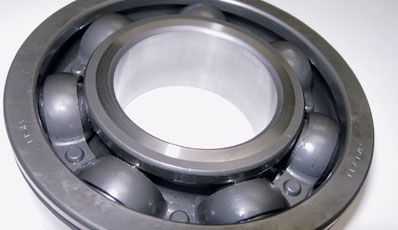
Bearings are usually taken for granted-until the bearing comes out in more pieces than when it went in. We'll explore the selection, installation and maintenance of various bearings which will allow you to keep your racer in top condition and give you a better shot at seeing that checkered flag.
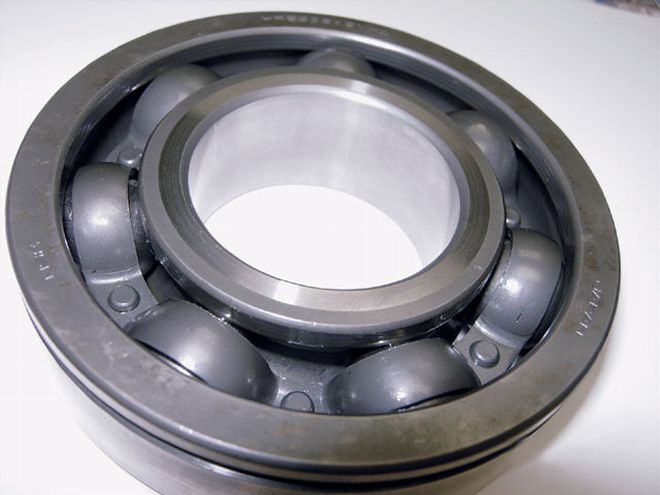 Ball bearing for Muncie transmission. Ramey Womer
Ball bearing for Muncie transmission. Ramey Womer
Types Of BearingsBall bearings Used in transmissions and differentials where minimal side loading is present.
Roller bearingsAlso used where minimal side loading is present. They can carry more load than ball bearings but do not tolerate misalignment as well. A roller bearing on the nose of a quick-change ring and pinion is a popular application.
Tapered roller bearingsThese are used for wheel bearings and as the main bearings on pinions. Another common name is "cups and cones." Tapered rollers are the only bearings that come apart readily.
Off-Season MaintenanceBearings require simple, yet critical routine maintenance to perform at their best. They can often be cleaned, re-lubed and reinstalled. But how do you know when to maintain them or when to replace them? Things to look for include:
DiscolorationAn overheated bearing will have a dull appearance, a black appearance or occasionally a rainbow effect. Don't even think about it-if you see discoloration replace the bearings.
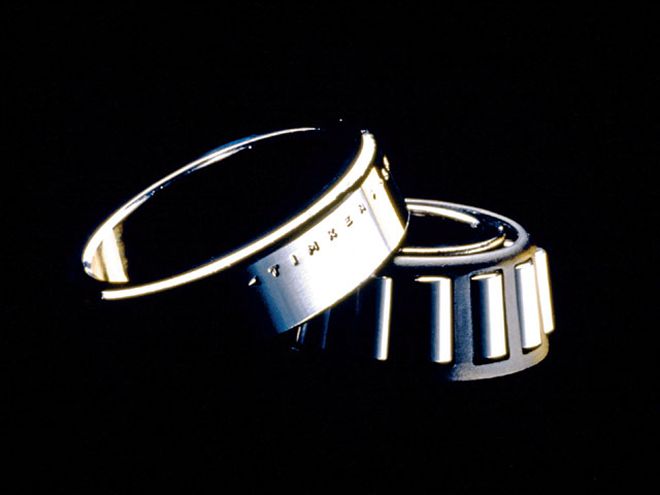 Tapered roller bearing cup and cone. Image courtesy of Timken
Tapered roller bearing cup and cone. Image courtesy of Timken
Pit marksPits on balls, rollers or races indicate a need for replacement. One of the best inspection items for your toolbox is a 10x loupe or a spark plug reading tool. Close inspection with magnification can give you a good idea of a bearing's true condition.
RoughnessRoughness in a bearing invites failure. Bearings should roll without any skips or bumps. Blemishes in the raceway or on the moving components give problems a place to start. If you can detect roughness, replace the bearings.
Normal wearNormal wear in a bearing is shown by shiny balls or rollers moving in shiny or slightly satin-like raceways. A smooth running bearing in this visual condition can be safely reused.
Cleaning A BearingBearings are precision instruments and should be treated as such. In most cases, off-the-shelf bearings are more precise than the parts in the engine. Begin by wiping excess grease, oil and dirt from the bearing using a lint-free cloth. Industrial wipers are becoming increasingly popular.
Immerse the bearing in a parts cleaning solution and brush until all traces of grease and dirt are gone. Keeping a separate container of "clean" solvent is a good idea for final rinsing. Speedway Motors offers an ultrasonic cleaner which is fantastic for removing the last traces of solvent from the bearings. Ultrasonic cleaners use sound waves to dislodge dirt from hard-to-reach places. You'd be surprised at what comes out of a supposedly clean bearing.
Blow the bearing dry using properly dried shop air or nitrogen from your tire tank and let drain on a lint free wiper or on an industrial absorbent mat. (Note: All of us have spun a bearing with compressed air to hear that cool spinning sound. Be advised this is very dangerous and can cause the bearing to come apart with great force. Always hold the bearing against a clean wipe while blowing it dry.) Cover the bearings if not installing them right away, as grinder dust has a way of sticking to everything. For best results, grease only the bearings you plan to immediately install. Spending some extra time and taking the proper precautions now will make a difference in how long your bearings last later.
Bearing InstallationBearings should never be forced into position in an uncontrolled manner. When installing races (cups) into hubs, the race should be pressed against the outer edge. Never use the bearing cone to press the race into position. Excess pressure, such as required to press a race into a hub, can cause microscopic indentations in the race and accelerate the failure process. Bearing cups should be installed using a dedicated installation tool or a properly sized socket.
Installing races by using a press allows the race to be seated with enough force to ensure a consistent bearing preload. Normal running can cause the bearing cup to seat after a few laps and require readjustment. It's always good to check but there's less chance of a change using the press method instead of hammering. Races can be installed using a soft steel drift and a hammer (Timken Engineering mentions brass can chip easily and leave debris in your bearing). Care should be taken not to allow too much variation in the angle of installation.
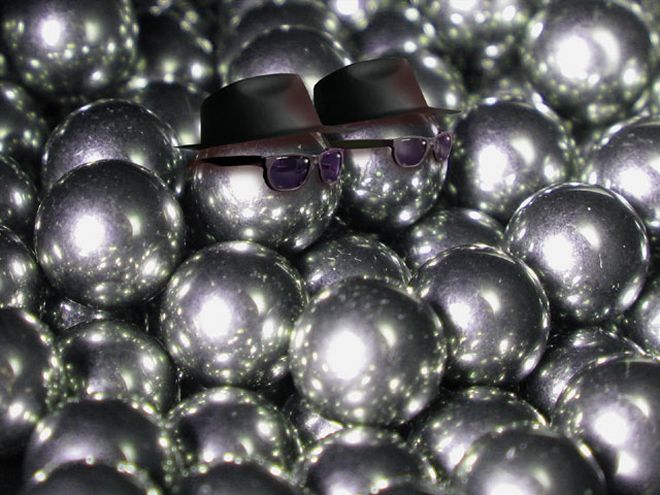
Installation of the first taper cone onto a pinion should be accomplished by pressing on the inner ring. A good tip for bearing installation onto a pinion is to freeze the pinion beforehand and heat the bearing in an oven or on a gas grill-off to the side, away from the open flame. For bearings such as Timken standard class bearings, temperatures should not exceed 300 F or the bearing heat treating could be affected. As always, consult the bearing manufacturer for exact temperature specifications. A hot bearing should fall right onto a frozen pinion. Take care to hold the bearing against the face of the pinion until the temperatures stabilize. The engineers at Timken have seen pinion bearings creep away a few thousandths after seemingly being seated properly. Holding the bearing against the surface should prevent that. It's a good idea to check with a thin feeler gauge or by holding the pinion up to a bright light to check for gaps.
Greased UpGrease is simply base oil with the addition of thickeners and additives. Bearings require clean grease of the proper type and in the proper amount. Most racecar hubs use tapered roller bearings which require NLGI-2 grease. The NLGI grade is a representation of the thickness with No. 2 being "moderately soft." A second NLGI designation to look for is "GC." The GC designation shows the grease has met the NLGI's highest standards for wheel bearing grease.
As a side note, currently the highest designation for chassis grease is LB. Premium multi-purpose grease is often designated NLGI-2 GC-LB. While brand and formulation are a hot topic, what really matters is using the proper grade of grease and keeping it clean. A bearing over-filled with dirty expensive grease will probably fail more quickly than one packed properly with clean fresh general purpose product.
How much grease should you use? Bearing manufacturers list the amount of grease (in cc's) required in their technical literature. For those who don't research this type of thing, here's a rule of thumb: Use as much grease as it takes to fill the voids in the bearing and leave just a bit on the outside. Extra grease invites dirt and causes overheating due to an effect called "churning." As far as grade goes, a quick survey of greases in my cabinet yielded NLGI-2 for the most part, along with a few tubs of ultra-sticky NLGI-3 wheel bearing grease. Would using the "3" be a deal breaker? Probably not, but it doesn't hurt to check before using. Preventing cross contamination is an important part of your bearing maintenance program. Using a dedicated tub of grease or grease gun can help maintain system cleanliness. We're all guilty of greasing the truck then pumping grease into a dirty hand to pack wheel bearings. If you do this, you may as well skip the seal since you'll have dirt already in there.
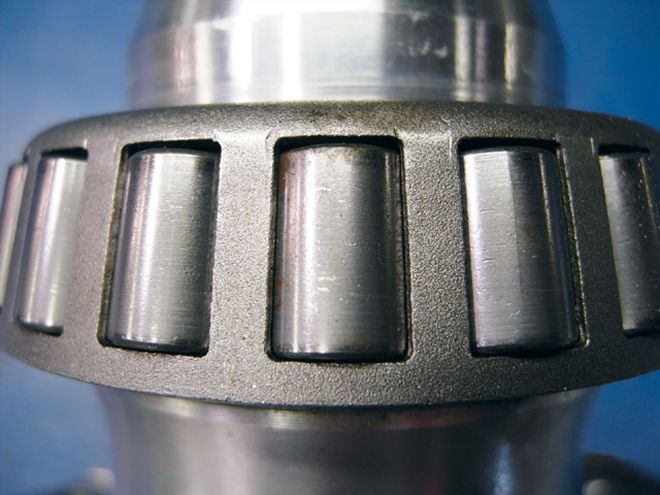 Tapered roller showing signs of wear on roller face. This one is a candidate for replacement. Ramey Womer
Tapered roller showing signs of wear on roller face. This one is a candidate for replacement. Ramey Womer
How To Tighten Tapered BearingsNow, you should have clean wheel bearings ready to be installed into the hubs. After the hub is placed on the spindle, the wheel bearings should be tightened as follows:
Remove the inner seal if not removed already. This allows the drag adjustment to be felt more easily.
Install bearing cones into the cups in the hub without greasing the bearings (for new bearings) or use freshly cleaned bearings.
Install and tighten the locknut, but do not over tighten. This can damage the bearing as discussed above. Continue tightening until drag is felt while rotating the hub. The bearing is now in a neutral position.
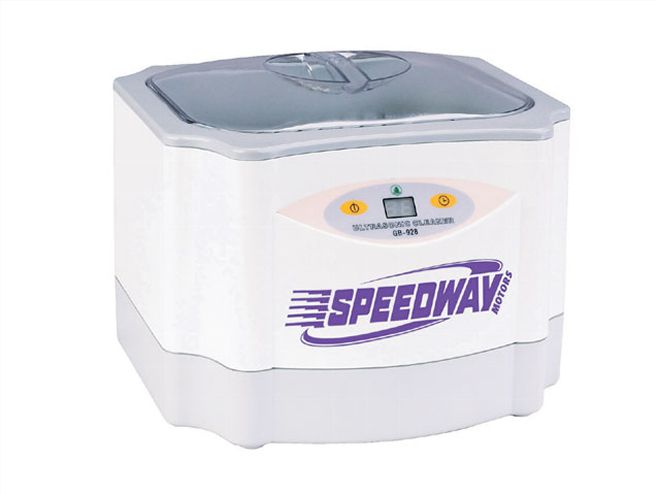 Speedway Motors offers this ultrasonic cleaner. Image courtesy of Speedway Motors
Speedway Motors offers this ultrasonic cleaner. Image courtesy of Speedway Motors
Use a dial indicator mounted to the axle tube or other suitable surface. Loosen the lock nut slightly. Total free play should be 0.001 inch along the centerline of the axle.
Mark the locknut.
Remove, assemble seal, grease bearings and reinstall.
Tighten locknut to previous mark.
TechnologyTimken Motorsports Products Timken has released a specialized wheel bearing kit with components aimed at reducing friction and increasing reliability. Kits are available for both Wide-5 and 5x5 applications. The kit includes a specialized cup and cone, a low drag seal and grease optimized for racing. The cups feature superfinished surfaces while the cones have a geometry optimized for wheel end usage. The low drag seal is of a two-piece labyrinth design, which means each half of the seal mates directly to the hub and axle and does not contact itself. Less friction is realized due to this design.
In addition to the low-drag wheel bearing kits, Timken has introduced a system called RacePac. The high-end RacePac system is composed of a superspeedway hub pre-loaded with motorsports specific bearings, a low-drag seal and the proper grease. Perhaps the most important aspect of the RacePac system is the spacer package which places an exact amount of preload on the bearing cones. This preload (which is difficult to obtain without specialized tools, measuring equipment or training) makes for a rigid assembly with a good combination of low drag and long life.
Super FinishingThe surfaces of quality bearings are obviously very smooth with regard to the balls, rollers and rolling surfaces. In the quest for speed and reliability, some bearing manufacturers and aftermarket companies have moved into the world of superfinishing. The components of a bearing, when magnified under a microscope, show a world of peaks and valleys. Superfinishing removes the peaks and provides a microscopically smoother rolling surface. The most popular superfinishing process is known as REM finishing-so much so that quite a few racing components are advertised as being "REM'd." The REM ISF (Isotropic Superfinish) process reduces heat and friction due to the microscopic peak removal and also provides a bright and shiny appearance.
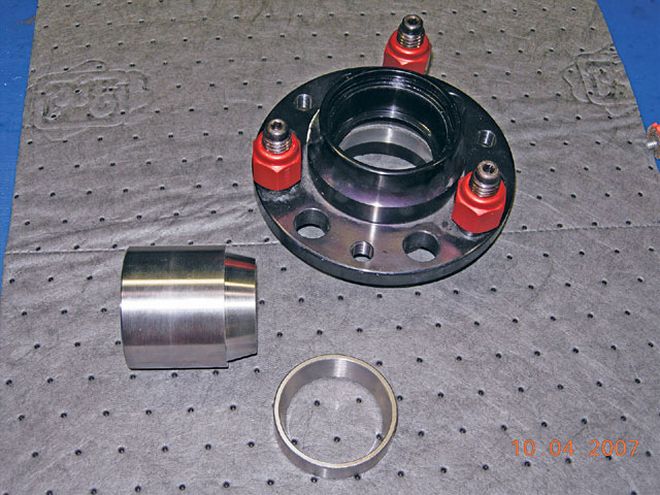 Six-pin hub, Holt Precision driver and bearing cup. Ramey Womer
Six-pin hub, Holt Precision driver and bearing cup. Ramey Womer
Cryogenic TemperingCryogenic tempering is the process of cooling a material (in this case, a bearing) in a controlled manner to temperatures as low as minus 300 F. The "cryo" process serves to realign molecules in the metal in order to reduce internal stresses and increase durability, scuff resistance and toughness. Bill Groschen, president of Diversified Cryogenics, mentions his company routinely treats a wide variety of racecar parts including bearings, engine parts, and driveline parts. Bearings which have been cryogenically treated tend to show substantially less wear and galling. With this technology, bearings can be treated in assembled condition (i.e. ball and roller bearings) and returned to service with no noticeable difference in appearance but with a substantial increase in performance and service life. It's important to note that some bearings do not respond favorably to this type of treatment. Consult your bearing manufacturer before sending them to a cryogenic treatment facility. Even though they may look the same, bearings are quite often made from substantially different alloys brand-to-brand.
Ceramic BearingsThe ceramic in ceramic bearings actually refers to the composition of the rolling elements (i.e. the balls and rollers). The rolling elements are made from Silicon Nitride, which can be built extremely hard, round and smooth. As balls and rollers become more round, the bearing can run with less rolling resistance. Hardness provides for less deflection in the bearing system which in turn can stabilize operating conditions. Smoothness obviously decreases friction. While researching bearing technology for this article, we found there were more questions than answers with regards to ceramic bearing technology and that using ceramic bearings requires careful engineering (in addition to a large bankroll). Caution should be taken to source bearings from a reliable manufacturer who can provide proper engineering data and advice. Simply replacing steel balls with ceramics does not work in all cases. As bearings heat and cool, the clearances designed for steel rolling elements may not be correct for ceramics. A ceramic bearing intended for use in an industrial environment, for example, may fail in a racing application. With all that being said, ceramics can offer a reduction in friction with an increase in life and speed.
A carefully maintained bearing program can pay dividends with regards to speed and reliability. With a bit of technology research, and specifying certain bearings and processes, further gains can be realized, which just may put your car to the front of the pack.